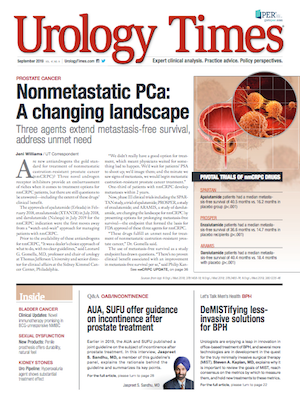Publication
Article
Urology Times Journal
Antiandrogens may increase mortality risk in men with CVD
Author(s):
Patients with CVD taking abiraterone or enzalutamide have a 43% higher risk of hospitalization, according to a recent study.

Advanced prostate cancer and cardiovascular disease often coexist in older men. Over the last 5 years, new second-generation antiandrogens, namely abiraterone (ZYTIGA) and enzalutamide (XTANDI), are being used with more frequency in men with advanced prostate cancer. Patients with significant cardiovascular disease (CVD) are often excluded from clinical trials for reasons that are understandable. But in clinical practice, the excluded patients are often the ones treated with those same medications.
A new study suggests that newer antiandrogens may increase the risk of early mortality and hospitalization, especially in men with known CVD such as myocardial infarction, atrial fibrillation, congestive heart failure, stroke, or ischemic heart disease (Eur Urol Aug. 2, 2019 [Epub ahead of print]).
Lu-Yao and colleagues used the Surveillance, Epidemiology, and End Results (SEER)-Medicare-linked files (representing nearly 31% of the U.S. population) to identify men with prostate cancer who had received chemotherapy and abiraterone or enzalutamide. A total of 3,876 patients were eligible for the study, including 2,845 treated with abiraterone and 1,031 treated with enzalutamide. The main goal of the analysis was to determine the mortality rate within 6 months after starting therapy with these two antiandrogens. They also wished to determine the risk of hospitalization after the initiation of antiandrogen therapy.
Also from Dr. Mian: Untreated MIBC has short natural course, significant morbidity
Interestingly, 67% of the eligible patients had one or more documented CVD before receiving abiraterone or enzalutamide.
In the post-chemotherapy group of patients being treated with abiraterone, 24% died within 6 months, compared with 17% in the pivotal trial that led to its approval. Among patients being treated with enzalutamide, 28% died within 6 months, compared with 12% in the pivotal trial. In the group without chemotherapy, 18% of patients died within 6 months of starting abiraterone and 17% died within 6 months of starting enzalutamide.
In the post-chemotherapy cohort receiving either abiraterone or enzalutamide, there was no significant difference in hospitalization rates between the two drugs. However, those with one or two CVDs had a 43% increased risk of hospitalization compared to those with no CVDs.
Next: Higher hospitalization rate in abi patients with no chemoHigher hospitalization rate in abi patients with no chemo
In the group without chemotherapy, abiraterone was associated with a higher rate of hospitalization than enzalutamide among patients with one or more CVDs. In this group, hospitalization rate was higher with abiraterone use even in the patients with no history of CVD.
As stated by the authors, the worse outcomes (cardiovascular toxicity and/or mortality) following the use of abiraterone have been reported by previously published meta-analyses. In the STAMPEDE trial, the addition of abiraterone was associated with improved cancer-free-survival but no real improvement in overall survival, likely due to increased cardiovascular mortality.
It appears that abiraterone is associated with worse outcomes even if there is no documented chemotherapy or CVDs. However, without direct comparison, we cannot suggest that one drug is superior to the other. Other antiandrogens such as apalutamide (Erleada) and darolutamide (Nubeqa) have been approved recently and the use of antiandrogens has been moving “upfront;” eg, before chemotherapy and without metastases. This will likely result in increased use of drugs in this class, making the issue of adverse outcomes even more relevant.
Read: Renal mass biopsy safe, but when is it necessary?
The usual limitations of a retrospective analysis apply to this study as well. The data do not allow for a comparison with an appropriate control group that did not receive abiraterone or enzalutamide, or direct comparison. However, the Medicare-linked SEER data represent a broad cross-section of the population that is afflicted with prostate cancer and CVDs, which makes the information presented here quite pertinent for most clinicians.
The phenomenon of worse outcomes in the real-world setting after the initial approval of a drug or device has been well documented. Clinicians often loosen the criteria beyond what was allowed in the clinical trials, exposing the patients to a host of drug-drug or drug-disease interactions.
The subjects of this study had also received androgen deprivation therapy, which is associated with developing CVDs. Is it possible that these subjects were primed, through previous use of ADT, for worse outcomes following the addition of abiraterone and enzalutamide? The unique contribution of these second-generation antiandrogens to cardiovascular mortality is not entirely clear.
Several professional organizations are offering workshops geared towards incorporating these and other oral anti-cancer agents into the practice of urology. Hopefully, the educational activities will sufficiently emphasize a more careful selection of patients for these drugs. There is clear impetus for a multidisciplinary program to monitor the treatment and adverse outcomes of newer antiandrogens which, at present, may be out of the comfort zone of many urologists.





























